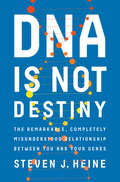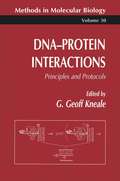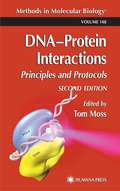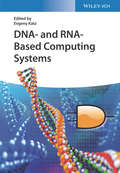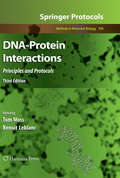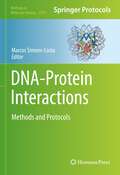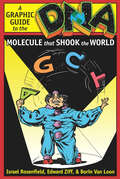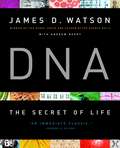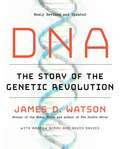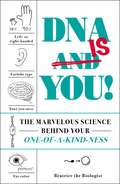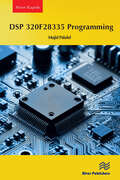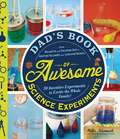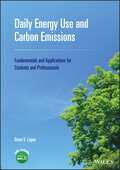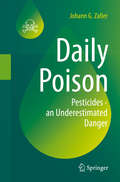- Table View
- List View
DNA and RNA Origami: Methods and Protocols (Methods in Molecular Biology #2639)
by Julián ValeroThis volume detials diverse methodological approaches on the assembly and applications of DNA origami assemblies. Chapters guide readers through different synthetic and computational methods, isolation and structural characterization of 2D and 3D DNA origami nanoarchitectures, nanophotonics, drug delivery, biophysics, and synthetic biology.Written in the successful Methods in Molecular Biology series format, chapters include introductions to their respective topics, lists of the necessary materials and reagents, step-by-step, readily reproducible protocols, and notes on troubleshooting and avoiding known pitfalls. Authoritative and cutting-edge, DNA and RNA Origami: Methods and Protocols aims to serve as a guideline describing the current state-of-the-art assembly methodologies and applications of DNA origami nanostructures.
DNA is Not Destiny
by Steven J. HeineDo you fear what might be lurking in your DNA?Well, now you can find out, and you most likely will. Scientists expect one billion people to have their genomes sequenced by 2025, and as the price drops it may even become a standard medical procedure. Yet cultural psychologist Steven Heine argues that the first thing we'll do upon receiving our DNA test results is to misinterpret them completely. We've become accustomed to breathless media coverage about newly discovered "cancer" or "IQ" or "infidelity" genes, each one promising a deeper understanding of what makes us tick. But as Heine shows, most of these claims are oversimplified and overhyped misinterpretations of how our DNA really works. With few exceptions, it is a complex combination of experience, environment, and genetics that determines who we are, how we behave, and what diseases will afflict us in the future. So why do we continue to buy into the belief that our genes control our destiny? Heine argues that we are psychologically ill equipped to deal with DNA results, repeatedly falling into predictable biases--switch-thinking, essentialism, fatalism, negativity dominance, and more--that mold our thinking about the information we receive. Heine shares his research--and his own genome-sequencing results--to not only to set the record straight regarding what your genes actually reveal about your health, intelligence, ethnic identity, and family, but to also help you counteract these insidious cognitive traps. His fresh, surprising conclusions about the promise, and limits, of genetic engineering and DNA testing upend conventional thinking and reveal a simple, profound truth: your genes create life--but they do not control it.
DNA'Protein Interactions
by G. Geoff KnealeThe clear and easy-to-follow protocols collected here illuminate the molecular basis of protein-nucleic acid interactions. Use them successfully to reveal the location of the DNA binding site, the strength and specificity of a binding, the identities of individual groups on the actual bases involved in binding, and the specific amino acid residues of the protein that interact with the DNA. Some of the techniques can even be used to identify previously unknown DNA binding proteins from crude cell extracts, thus empowering you to make groundbreaking advances in your work.
DNA'Protein Interactions
by Tom MossDr. Tom Moss assembles the new standard collection of cutting-edge techniques to identify key protein-DNA interactions and define their components, their manner of interaction, and their manner of function, both in the cell and in the test tube. The techniques span a wide range, from factor identification to atomic detail, and include multiple DNA footprinting analyses, including in vivo strategies, gel shift (EMSA) optimization, SELEX, surface plasmon resonance, site-specific DNA-protein crosslinking, and UV laser crosslinking. Comprehensive and broad ranging, DNA-Protein Interactions: Principles and Protocols, 2nd Edition, offers a stellar array of over 100 up-to-date and readily reproducible techniques that biochemists and molecular, cellular, and developmental biologists can use successfully today to understand DNA-protein interactions.
DNA, Race, and Reproduction
by Emily Klancher Merchant and Meaghan O’KeefeA free ebook version of this title is available through Luminos, University of California Press's Open Access publishing program. Visit www.luminosoa.org to learn more.DNA, Race, and Reproduction helps readers inside and outside of academia evaluate and engage with the current genomic landscape. It brings together expertise in law, medicine, religion, history, anthropology, philosophy, and genetics to examine how scientists, medical professionals, and laypeople use genomic concepts to construct racial identity and make or advise reproductive decisions, often at the same moment. It critically and accessibly interrogates how DNA figures in the reproduction of racialized bodies and the racialization of reproduction and examines the privileged position from which genomic knowledge claims to speak about human bodies, societies, and activities. The volume begins from the premise that reproduction, regardless of the means, forces a confrontation between biomedical, scientific, and popular understandings of genetics, and that those understandings are often racialized. It therefore centers reproduction as both a site of analysis and an analytic lens.
DNA- and RNA-Based Computing Systems
by Evgeny KatzDiscover the science of biocomputing with this comprehensive and forward-looking new resource DNA- and RNA-Based Computing Systems delivers an authoritative overview of DNA- and RNA-based biocomputing systems that touches on cutting-edge advancements in computer science, biotechnology, nanotechnology, and materials science. Accomplished researcher, academic, and author Evgeny Katz offers readers an examination of the intersection of computational, chemical, materials, and engineering aspects of biomolecular information processing. A perfect companion to the recently published Enzyme-Based Computing by the same editor, the book is an authoritative reference for those who hope to better understand DNA- and RNA-based logic gates, multi-component logic networks, combinatorial calculators, and related computational systems that have recently been developed for use in biocomputing devices. DNA- and RNA-Based Computing Systems summarizes the latest research efforts in this rapidly evolving field and points to possible future research foci. Along with an examination of potential applications in biosensing and bioactuation, particularly in the field of biomedicine, the book also includes topics like: A thorough introduction to the fields of DNA and RNA computing, including DNA/enzyme circuits A description of DNA logic gates, switches and circuits, and how to program them An introduction to photonic logic using DNA and RNA The development and applications of DNA computing for use in databases and robotics Perfect for biochemists, biotechnologists, materials scientists, and bioengineers, DNA- and RNA-Based Computing Systems also belongs on the bookshelves of computer technologists and electrical engineers who seek to improve their understanding of biomolecular information processing. Senior undergraduate students and graduate students in biochemistry, materials science, and computer science will also benefit from this book.
DNA-Encoded Chemical Libraries: Methods and Protocols (Methods in Molecular Biology #2541)
by David Israel Yun DingThis volume discusses protocols that cover synthesis, screening by selection, and analysis of DNA-encoded chemical libraries (DEL). Chapters in this book focus on methods used to practice DEL technology and include solution phase library synthesis using a variety of chemistries; DNA encoding of chemical structure; design, preparation and analysis of target proteins and tool compounds; screening of soluble protein targets by affinity selection; DEL qPCR, preparative PCR and DNA sequence analysis; computational methods used to analyze selections and choose compounds for resynthesis; and analysis of hit compounds. Written in the highly successful Methods in Molecular Biology series format, chapters include introductions to their respective topics, lists of the necessary materials and reagents, step-by-step, readily reproducible laboratory protocols, and tips on troubleshooting and avoiding known pitfalls.Cutting-edge and comprehensive, DNA-Encoded Chemical Libraries: Methods and Protocols is a valuable resource for scientists interested in DEL technology for drug discovery, and will contribute to the continued advancement in this important field.
DNA-Encoded Libraries (Topics in Medicinal Chemistry #40)
by Andreas Brunschweiger Damian W. YoungThis book deals with the recent advances in DNA-Encoded Library (DEL) technology that has emerged as an alternative to high throughput screening (HTS) over the last decade and has been heralded as a "disruptive" technology for drug discovery. The book aims to provide a comprehensive overview of all of the major components of the DEL process from conception to bench execution and clinical investigations. The contributions from experts in the field combine different perspectives from academia and industry. The book will be of interest to researchers in the drug discovery field as well as to graduate students and scholars who are interested in this rapidly improving technology.
DNA-Protein Interactions
by Tom Moss Benoît LeblancGene expression can mean the difference between a functional and non-functional genome, between health and disease, and with the development of transgenic crops, the difference between survival and starvation. In DNA-Protein Interactions: Principles and Protocols, Third Edition, this vital subject is brought up to date with protocols exploring the most cutting-edge developments in the field, including in vivo and genome-wide interaction techniques. Addressing topics such as chromatin immunoprecipitation, topological studies, photocrosslinking, FRET and imaging techniques, the volume fully updates and expands upon the successful previous editions. Written in the convenient and informative Methods in Molecular BiologyTM series format, chapters include introductions to their respective subjects, lists of the necessary materials and reagents, step-by-step, readily reproducible laboratory protocols, and notes on troubleshooting and avoiding known pitfalls. Comprehensive and authoritative, DNA-Protein Interactions: Principles and Protocols, Third Edition serves as an ideal guide for all those exploring this dynamic, essential, and increasingly affordable area of research.
DNA-Protein Interactions: Methods and Protocols (Methods in Molecular Biology #2599)
by Marcos Simoes-CostaThis volume details protocols emphasizing systems-level approaches that can be applied to genomic analyses. Chapters detail techniques for optimized application in in vivo systems, spatial, physiological, environmental contexts, imaging-based techniques, single-molecule approaches, CRISPR systems, new genomic approaches, and measurements of kinetics governing. Written in the format of the highly successful Methods in Molecular Biology series, each chapter includes an introduction to the topic, lists necessary materials and reagents, includes tips on troubleshooting and known pitfalls, and step-by-step, readily reproducible protocols. Authoritative and cutting-edge, DNA-Protein Interactions: Methods and Protocols aims to present genome-wide techniques that will complement the biochemistry-based protocols to aid researchers in their studies.
DNA: A Graphic Guide To The Molecule That Shook The World (A\writers And Readers Documentary Comic Ser.)
by Edward Ziff Israel Rosenfield Borin Van LoonWith humor, depth, and philosophical and historical insight, DNA reaches out to a wide range of readers with its graphic portrayal of a complicated science. Suitable for use in and out of the classroom, this volume covers DNA's many marvels, from its original discovery in 1869 to early-twentieth-century debates on the mechanisms of inheritance and the deeper nature of life's evolution and variety. Even readers who lack a background in science and philosophy will learn a tremendous amount from this engaging narrative. The book elucidates DNA's relationship to health and the cause and cure of disease. It also covers the creation of new life forms, nanomachines, and perspectives on crime detection, and considers the philosophical sources of classical Darwinian theory and recent, radical changes in the understanding of evolution itself. Already these developments have profoundly affected our notions about living things. Borin Van Loon's humorous illustrations recount the contributions of Gregor Mendel, Frederick Griffith, James Watson, and Francis Crick, among other biologists, scientists, and researchers, and vividly depict the modern controversies surrounding the Human Genome Project and cloning.
DNA: A Graphic Guide to the Molecule that Shook the World
by Edward Ziff Israel Rosenfield Borin Van LoonA graphic portrayal of a complicated science for a wide range of readers, full of humor, depth, and philosophical and historical insight. Suitable for use in and out of the classroom, this volume covers DNA&’s many marvels, from its original discovery in 1869 to early-twentieth-century debates on the mechanisms of inheritance and the deeper nature of life&’s evolution and variety. Even readers who lack a background in science and philosophy will learn a tremendous amount from this engaging narrative. The book elucidates DNA&’s relationship to health and the cause and cure of disease. It also covers the creation of new life forms, nanomachines, and perspectives on crime detection, and considers the philosophical sources of classical Darwinian theory and recent, radical changes in the understanding of evolution itself. Already these developments have profoundly affected our notions about living things. Borin Van Loon&’s humorous illustrations recount the contributions of Gregor Mendel, Frederick Griffith, James Watson, and Francis Crick, among other biologists, scientists, and researchers, and vividly depict the modern controversies surrounding the Human Genome Project and cloning. &“A unique, richly detailed, and fun biography of DNA grounded in deep historical and philosophical knowledge . . . Everything we need to know about biology&’s most important molecule.&” —Olive Sacks, author of Everything In Its Place &“A remarkable book . . . Novel, easy to read, and fun . . . I spent many years mastering genetics yet learned new and valuable things from this book.&” —Robert Trivers, author of Wild Life: Adventures of an Evolutionary Biologist
DNA: Promise and Peril
by Linda L. Mccabe Edward R. B. MccabeThis book gives the background information critical to understanding how genetics is now affecting our everyday lives. It gives a comprehensive view of exciting recent discoveries and explores the ethical, legal, and social issues that have arisen with each new development.
DNA: The Secret of Life
by James D. Watson Andrew BerryOne of the discoverers of the double-helix shape of DNA marks the 50th anniversary of the event by tracing how the field of genetics has evolved from there to the mapping of the human genome. He writes for general readers who need not have knowledge about biology. Annotation ©2004 Book News, Inc. , Portland, OR (booknews. com)
DNA: The Story of the Genetic Revolution
by James D. Watson Andrew Berry Kevin DaviesThe definitive insider's history of the genetic revolution--significantly updated to reflect the discoveries of the last decade. James D. Watson, the Nobel laureate whose pioneering work helped unlock the mystery of DNA's structure, charts the greatest scientific journey of our time, from the discovery of the double helix to today's controversies to what the future may hold. Updated to include new findings in gene editing, epigenetics, agricultural chemistry, as well as two entirely new chapters on personal genomics and cancer research. This is the most comprehensive and authoritative exploration of DNA's impact--practical, social, and ethical--on our society and our world.
DNAPL Site Evaluation
by Robert M. Cohen James W. MercerDNAPL Site Evaluation covers long-term contamination of ground water by DNAPL (dense non-aqueous phase liquids) chemicals. The book develops a framework for planning and implementing DNAPL site characterization activities. It provides detailed methods to identify, characterize, and monitor sites and analyzes their utility, limitations, risks, availability, and cost. Methods to interpret contaminant fate and transport are identified, and new site characterization methods are assessed. DNAPL Site Evaluation will maximize the cost-effectiveness of site investigation/remediation by providing the best information available to describe and evaluate methods to be used for determining the presence, fate, and transport of subsurface DNAPL contamination. The book will be a useful reference for groundwater professionals and environmental regulatory personnel.
DNAzymes: Methods and Protocols (Methods in Molecular Biology #2439)
by Gerhard Steger Hannah Rosenbach Ingrid SpanThis volume explores a collection of different protocols for the analysis and characterization of DNAzymes and their functions. The topics covered in this book range from bioinformatics and molecular dynamics simulations for the study or modification of nucleic acids to the descriptions of spectroscopic, fluorescence-based, or crystallographic methods to understand the structure and function of DNAzymes. Written in the highly successful Methods in Molecular Biology series format, chapters include introductions to their respective topics, lists of the necessary materials and reagents, step-by-step, readily reproducible laboratory protocols, and tips on troubleshooting and avoiding known pitfalls.Cutting-edge and comprehensive, DNAzymes: Methods and Protocols is a valuable resource for scientists and researchers interested in learning more about this evolving field.
DNA Is You!: The Marvelous Science Behind Your One-of-a-Kind-ness
by Beatrice The BiologistLearn all about how your DNA makes you who you are—an awesome, unique individual—in this fun and simple illustrated guide! Did you know your sense of purpose is determined by your genes? And that DNA determines your reaction to poison ivy, and maybe even your sex drive? In DNA Is You!, the author behind Beatrice the Biologist uses her trademark humor to break down the ins and outs of DNA to give you the low-down on each trait, one by one. She provides the answers to questions like: how dependent are traits on your parents’ genes? Are they based on mutations or influenced by the environment? What kind of studies have been performed on genetics, and what have they discovered? Home DNA tests are more popular than ever, and DNA Is You! takes a look at the weird and wild scientific factors that can change your genes—like that dimples are dominant, how someone gets two different eye colors, and which genes determine whether or not you’ll need glasses. Learn more about how you got to be who you are with DNA Is You! and understand yourself—and your family—a little bit better!
DNS of Wall-Bounded Turbulent Flows: A First Principle Approach
by Tapan K. Sengupta Swagata BhaumikThis book highlights by careful documentation of developments what led to tracking the growth of deterministic disturbances inside the shear layer from receptivity to fully developed turbulent flow stages. Associated theoretical and numerical developments are addressed from basic level so that an uninitiated reader can also follow the materials which lead to the solution of a long-standing problem. Solving Navier-Stokes equation by direct numerical simulation (DNS) from the first principle has been considered as one of the most challenging problems of understanding what causes transition to turbulence. Therefore, this book is a very useful addition to advanced CFD and advanced fluid mechanics courses.
DSM: A History of Psychiatry's Bible
by Allan V. HorwitzThe first comprehensive history of "psychiatry's bible"—the Diagnostic and Statistical Manual of Mental Disorders.Over the past seventy years, the Diagnostic and Statistical Manual of Mental Disorders, or DSM, has evolved from a virtually unknown and little-used pamphlet to an imposing and comprehensive compendium of mental disorder. Its nearly 300 conditions have become the touchstones for the diagnoses that patients receive, students are taught, researchers study, insurers reimburse, and drug companies promote. Although the manual is portrayed as an authoritative corpus of psychiatric knowledge, it is a product of intense political conflicts, dissension, and factionalism. The manual results from struggles among psychiatric researchers and clinicians, different mental health professions, and a variety of patient, familial, feminist, gay, and veterans' interest groups. The DSM is fundamentally a social document that both reflects and shapes the professional, economic, and cultural forces associated with its use.In DSM, Allan V. Horwitz examines how the manual, known colloquially as "psychiatry's bible," has been at the center of thinking about mental health in the United States since its original publication in 1952. The first book to examine its entire history, this volume draws on both archival sources and the literature on modern psychiatry to show how the history of the DSM is more a story of the growing social importance of psychiatric diagnoses than of increasing knowledge about the nature of mental disorder. Despite attempts to replace it, Horwitz argues that the DSM persists because its diagnostic entities are closely intertwined with too many interests that benefit from them. This comprehensive treatment should appeal to not only specialists but also anyone who is interested in how diagnoses of mental illness have evolved over the past seven decades—from unwanted and often imposed labels to resources that lead to valued mental health treatments and social services.
DSP 320F28335 Programming
by Majid PakdelThis book provides a comprehensive, practical approach to understanding and implementing the programming concepts of the DSP 320F28335 microcontroller. It is an indispensable guide for both seasoned professionals and beginners interested in mastering the complexities of programmable digital signal processors (DSPs).Inside, you will embark on a journey through the world of DSPs, exploring various programming techniques and strategies tailored specifically for the 320F28335 microcontroller. From the fundamentals of DSP programming to advanced signal processing algorithms, this book covers it all. Each chapter is carefully crafted, offering clear explanations, step-by-step examples, and hands-on exercises to reinforce your learning. You will learn how to harness the power of the 320F28335 microcontroller to develop real-time applications.Whether you are a seasoned programmer looking to expand your knowledge or a beginner ready to dive into the world of DSPs, "DSP 320F28335 Programming"" will be your ultimate companion. With its comprehensive coverage, insightful explanations, and practical examples, this book is a must-have resource for anyone aiming to excel in the realm of digital signal processing programming.
Dad's Book of Awesome Science Experiments: From Boiling Ice and Exploding Soap to Erupting Volcanoes and Launching Rockets, 30 Inventive Experiments to Excite the Whole Family!
by Mike Adamick<p>The science behind, "But, why?". <p>Don't get caught off guard by your kids' science questions! You and your family can learn all about the ins and outs of chemistry, biology, physics, the human body, and our planet with <i>Dad's Book of Awesome Science Experiments</i>. From Rock Candy Crystals to Magnetic Fields, each of these fun science projects features easy-to-understand instructions that can be carried out by even the youngest of lab partners, as well as awesome, full-color photographs that guide you through each step. Complete with 30 interactive experiments and explanations for how and why they work, this book will inspire your family to explore the science behind: <li>Chemistry, with Soap Clouds <li>Biology, with Hole-y Walls <li>Physics, with Straw Balloon Rocket Blasters <li>Planet Earth, with Acid Rain <li>The Human Body, with Marshmallow Pulse Keepers.</li> <p> <p>Best of all, every single one of these projects can be tossed together with items around the house or with inexpensive supplies from the grocery store. Whether your kid wants to create his or her own Mount Vesuvius or discover why leaves change colors in the fall, <i>Dad's Book of Awesome Science Experiments</i> will bring out the mad scientists in your family--in no time!
Daily Energy Use and Carbon Emissions: Fundamentals and Applications for Students and Professionals
by Bruce E. LoganProvides an accessible and relatable approach for understanding how much energy we use in our day-to-day lives Daily Energy Use and Carbon Emissions enables readers to directly evaluate their energy use, estimate the resulting carbon emissions, and use the information to better appreciate and address the impact their activities have on climate change. Using quantities and terms rooted in everyday life, this easy-to-understand textbook helps readers determine the energy they consume driving a car, preparing a meal, charging electronic devices, heating and cooling a house or apartment, and more. Throughout the text, clear explanations, accurate information, and numerous real-world examples help readers to answer key energy questions such as: How much energy does your house use in a month? What impact will turning off lightbulbs in your home have on energy conservation? Which car emits more CO2 into the atmosphere per mile, a 50 MPG gasoline car or a 100 MPG equivalent electric car? Demonstrating the relation between daily energy use, carbon emissions, and everyday activities in a new way, this innovative textbook: Examines daily activities within the context of the basic needs: energy, food, air, and water Covers topics such as daily water use, renewable energy, water and energy sources, transportation, concrete and steel, and carbon capture and storage Includes discussion of energy and CO2 emissions relative to infrastructure and population growth Provides supplemental teaching material including PowerPoint slides, illustrative examples, homework assignments, discussion questions, and classroom quizzes with answersDaily Energy Use and Carbon Emissions: Fundamentals and Applications for Students and Professionals is a perfect textbook for students and instructors in Environmental Engineering programs, and an essential read for those pursuing careers in areas related to energy, environment, and climate change.
Daily Poison: Pesticides - an Underestimated Danger
by Johann G. ZallerThis book is a sound science report about the consequences of pesticides to nature, health and environment.The book shares essential insights into the use of pesticides in agriculture, discusses the politics, rhetoric and profits involved, addresses the potential health and ecological risks of pesticides in our daily lives, and debates possible solutions. Does sustainable agriculture exist, and is agriculture without pesticides possible at all?Moreover, the author gives insight into his scientific work, the set-up of the experiments, and also writes about his very own experiences with the media and press after publication of his studies.For many years, Johann G. Zaller, an ecologist at the University of Natural Resources and Life Sciences in Vienna, and his team, have been researching applied chemicals and their effects on the environment. Their findings, together with relevant literature and media reports, are presented in this book, which offers a unique resource for anyone who wants to know the nature and background of pesticides and how we come into contact with them in our daily lives. Ever ate an apple? Read this book!
Daily Science (Daily Science Series #Grade 3)
by Evan-MoorFit standards-based science instruction into your curriculum! Help your grade 3 students develop a genuine understanding of standards-based scientific concepts and vocabulary using the 150 engaging activities in Daily Science! A variety of rich resources, including vocabulary practice, hands-on science activities, and comprehension tests in multiple-choice format, help you successfully introduce students to earth, life, and physical science concepts. <P><P> 30 weeks of instruction cover the following standards-based science topics: <P><P> Big Idea 1: Living things have adaptations that help them survive in their environment. <br> Week 1: Why do flowers have different colors and scents? <br>Week 2: How do dolphins sleep without drowning? <br>Week 3: Why does a cactus have needles? <br>Week 4: Why do birds migrate? <br>Week 5: Unit Review <P><P>Big Idea 2: Plants have many parts. Each part does a special job. <br>Week 1: What's the difference between a fruit and a vegetable? <br>Week 2: How does a tree get water from its roots to its leaves? <br>Week 3: Why do dandelions turn white and fluffy? <br>Week 4: Why do leaves change color in the fall? <br>Week 5: Unit Review <P><P>Big Idea 3: Fossils tell us about the plants and animals that lived long ago. <br>Week 1: Where is the best place to look for fossils? <br>Week 2: How do scientists know how old a fossil is? <br>Week 3: Why are fossils of ocean animals found on mountains today? <br>Week 4: How does something become a fossil? <br>Week 5: Unit Review <P><P>Big Idea 4: Air is a gas that surrounds us, takes up space, and creates weather. <br>Week 1: Why can't you breathe in outer space? <br>Week 2: Why does a can of soda sometimes explode when you open it? <br>Week 3: Where does wind come from? <br>Week 4: How do birds fly? <br>Week 5: Unit Review <P><P>Big Idea 5: Light moves in a straight line until it hits an object. Light can be absorbed, refracted, or reflected. <br>Week 1: Why does it get hot in the car on a sunny day when it is cold outside? <br>Week 2: Why does a straw look bent in a glass of water? <br>Week 3: Why do things look backward in a mirror? <br>Week 4: How does a movie projector work? <br>Week 5: Unit Review <P><P>Big Idea 6: Electricity travels in currents. It can pull and push the things around it. <br>Week 1: Where does lightning come from? <br>Week 2: Why do people get a shock when they touch metal? <br>Week 3: How does a battery make electricity? <br>Week 4: How does flipping a switch make a light bulb light up? <br>Week 5: Unit Review

